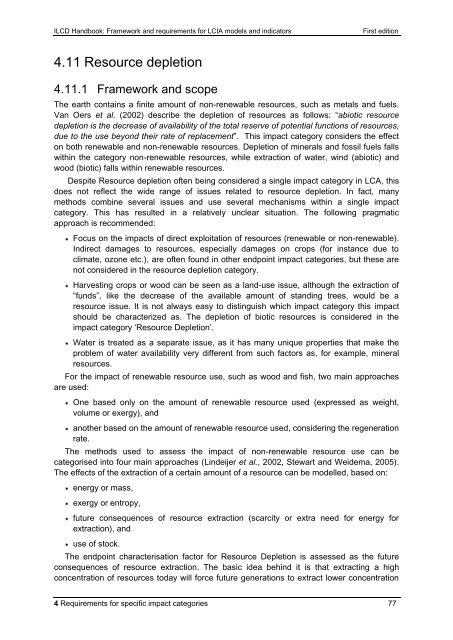ILCD Handbook: Framework and requirements for LCIA models and ...
ILCD Handbook: Framework and requirements for LCIA models and ...
ILCD Handbook: Framework and requirements for LCIA models and ...
You also want an ePaper? Increase the reach of your titles
YUMPU automatically turns print PDFs into web optimized ePapers that Google loves.
<strong>ILCD</strong> <strong>H<strong>and</strong>book</strong>: <strong>Framework</strong> <strong>and</strong> <strong>requirements</strong> <strong>for</strong> <strong>LCIA</strong> <strong>models</strong> <strong>and</strong> indicators First edition<br />
4.11 Resource depletion<br />
4.11.1 <strong>Framework</strong> <strong>and</strong> scope<br />
The earth contains a finite amount of non-renewable resources, such as metals <strong>and</strong> fuels.<br />
Van Oers et al. (2002) describe the depletion of resources as follows: ―abiotic resource<br />
depletion is the decrease of availability of the total reserve of potential functions of resources,<br />
due to the use beyond their rate of replacement‖. This impact category considers the effect<br />
on both renewable <strong>and</strong> non-renewable resources. Depletion of minerals <strong>and</strong> fossil fuels falls<br />
within the category non-renewable resources, while extraction of water, wind (abiotic) <strong>and</strong><br />
wood (biotic) falls within renewable resources.<br />
Despite Resource depletion often being considered a single impact category in LCA, this<br />
does not reflect the wide range of issues related to resource depletion. In fact, many<br />
methods combine several issues <strong>and</strong> use several mechanisms within a single impact<br />
category. This has resulted in a relatively unclear situation. The following pragmatic<br />
approach is recommended:<br />
Focus on the impacts of direct exploitation of resources (renewable or non-renewable).<br />
Indirect damages to resources, especially damages on crops (<strong>for</strong> instance due to<br />
climate, ozone etc.), are often found in other endpoint impact categories, but these are<br />
not considered in the resource depletion category.<br />
Harvesting crops or wood can be seen as a l<strong>and</strong>-use issue, although the extraction of<br />
―funds‖, like the decrease of the available amount of st<strong>and</strong>ing trees, would be a<br />
resource issue. It is not always easy to distinguish which impact category this impact<br />
should be characterized as. The depletion of biotic resources is considered in the<br />
impact category ‗Resource Depletion‘.<br />
Water is treated as a separate issue, as it has many unique properties that make the<br />
problem of water availability very different from such factors as, <strong>for</strong> example, mineral<br />
resources.<br />
For the impact of renewable resource use, such as wood <strong>and</strong> fish, two main approaches<br />
are used:<br />
One based only on the amount of renewable resource used (expressed as weight,<br />
volume or exergy), <strong>and</strong><br />
another based on the amount of renewable resource used, considering the regeneration<br />
rate.<br />
The methods used to assess the impact of non-renewable resource use can be<br />
categorised into four main approaches (Lindeijer et al., 2002, Stewart <strong>and</strong> Weidema, 2005).<br />
The effects of the extraction of a certain amount of a resource can be modelled, based on:<br />
energy or mass,<br />
exergy or entropy,<br />
future consequences of resource extraction (scarcity or extra need <strong>for</strong> energy <strong>for</strong><br />
extraction), <strong>and</strong><br />
use of stock.<br />
The endpoint characterisation factor <strong>for</strong> Resource Depletion is assessed as the future<br />
consequences of resource extraction. The basic idea behind it is that extracting a high<br />
concentration of resources today will <strong>for</strong>ce future generations to extract lower concentration<br />
4 Requirements <strong>for</strong> specific impact categories 77



